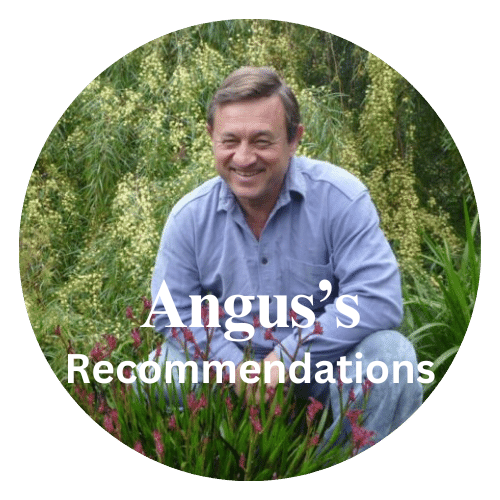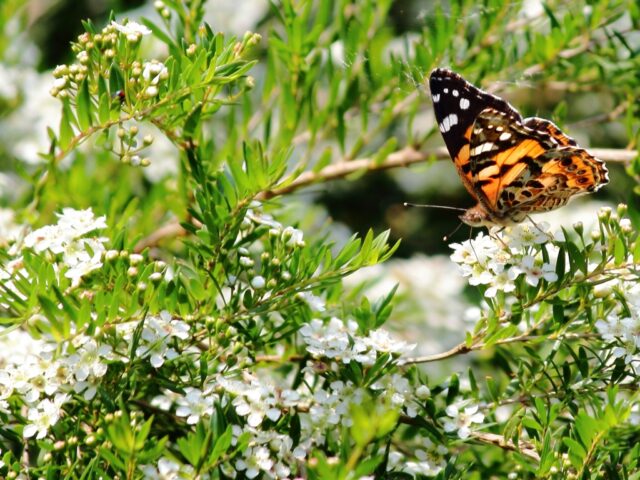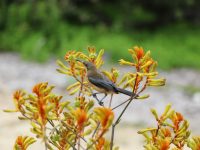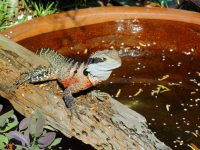In light of recent articles about the rapid decline of insect numbers, I’d like to take the opportunity in this month’s newsletter to look at practical ways we can personally help. There are many things we can do on an individual level, whether you live in a terrace or apartment with no back garden, a suburban block or a farm or larger property. If you want to be inspired, read on!
For many of us, our garden or outdoor space serves its purpose in our daily lives. It might be a quiet place to rest and relax. A place to sit in the morning or afternoon sun with a cup of tea and a book. A place where we can feel the breeze, hear the rustling of leaves, become cool in the shade on a hot summers day. Our garden or outdoor space might be a play area for our children or grandchildren, a place to hang the washing, a manicured landscaped garden, a pathway to the shed or laundry, a place to grow edible produce, a paved area or a place where nature runs wild! Either way our outdoor space, whether it be a small apartment terrace, or a large acreage, means something to us, as humans.
It seems to be easy to forget that what we consider to be our own outdoor space could also mean something to the wildlife that we share our earth with. As human population increases, the natural habitat of many living things decreases, and not just for the insects. With a little bit of knowledge and forward planning we can purposefully place things into our outdoor space that can help restore some of the natural environment that has been lost and which creatures both large and small rely on for life.
There are many different forms of life that we can consider if we want to provide habitats as part of our outdoor space. When we talk about creating habitats, people often think about the more obvious creatures, such as birds and butterflies. People love the ‘beauty’ that these certain types of creatures can bring. For example when a butterfly floats into the garden, it really is a majestic sight. Or when a flock of rainbow lorikeets choose your garden or balcony rail to sit on, it certainly does bring a deep joy!
In this article I’d like to delve a little deeper and consider the broad scope of creatures that we may be able to cater for in our outdoor dwellings. There’s a big diversity of lives that can utilise, visit or permanently live in our garden. Birds, possums, bats, butterflies, frogs, lizards, ants, beetles, earth worms, slaters, bees, moths, stick insects, praying mantis, ladybirds (just to name a few) and some creatures that live in soil and water that are too small for the human eye to see. Taking action to provide habitats starts with knowledge and understanding. Let’s take a closer look at some simple ways we can go about creating habitats.
If you live in a unit or an apartment, don’t be disheartened. You can still create some wonderful little habitats utilising a small amount of space. You might begin with attracting pollinators to your outdoor space. Pollinators are the insects responsible for spreading pollen from one flower to another. Bees are the most well-known pollinators, however, many more insects play a vital role in the pollination process. Many of the world’s crops are pollinator dependent. Without our busy little pollinating friends, we would not have all the fresh produce that we have today. If we look after them, they will continue to look after us.
Now that we know how important these little creatures are, let’s look at how we can provide habitat for them. Firstly, to attract pollinators, you will need some plants. If you like to use herbs in your cooking, a good way to go might be to plant a herb garden. Pollinators such as common bees, native bees and butterflies seem to find plants from the “Lamiaceae” family irresistible. Some plants from this family include:
- basil
- rosemary
- sage
- marjoram
- oregano
- thyme
- mint
- lavender
For those who may lack space, plants from the Lamiaceae family do really well in pots, hanging baskets and look sensational as a vertical wall garden. Gardens both large and small can benefit from the addition of these plants. All herbs in the Lamiaceae family are aromatic, so in addition to their flowers catering for pollinators, they are useful in the kitchen and can provide a wonderful sensory experience that anyone from babies to elderly and all in between can benefit from. There’s nothing quite like going into your own herb garden, looking at the herbs, touching the different textures of their leaves, smelling the aromas coming from their oils and tasting each one. Science says that smelling rosemary daily can improve memory and that many herbs have anti-bacterial and anti-fungal properties. Could the fresh herbs on your home made pizza make it a little bit medicinal as well as delicious?
Once you have established a garden and the pollinators begin to visit if you would like to encourage their permanent residence, you can look at adding something like a native bee hotel. They come in all different shapes and sizes, so even if those with smaller spaces can still consider having one. Many local plant nurseries stock these and they not only provide a home for our precious native bees, but they can also look like a sculpted work of art. If you have some artistic flare and a bit of extra time on your hands, you might even like to try and make one for yourself. A great activity to involve kids in!
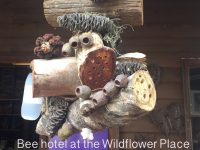 It should go without saying that minimising or eliminating insecticides from your garden is a must. The indiscriminate use of them is encouraged by advertising that suggests that all insects are bad, dirty, scary. Of course there are some insects that are so, such as disease carrying mosquitos, flies that land on your food etc. But there are good options for dealing with these other than spraying, which eliminates the good critters along with the bad. Making sure there are no sources of water for mosquitos to breed, and good old fashioned fly paper or the joy of whacking flies with a fly swat are good alternatives to destructive chemicals. It is useful to change thinking, from insects being invaders of your space, to looking at the place they have in a habitat. Insects can serve as a food source for other creatures such as birds and lizards, and for each other. Did you know that dragonflies not only look wonderful, they also eat mosquitos and other bugs? If you go around spraying everything in sight, then you poison beauties like these.
It should go without saying that minimising or eliminating insecticides from your garden is a must. The indiscriminate use of them is encouraged by advertising that suggests that all insects are bad, dirty, scary. Of course there are some insects that are so, such as disease carrying mosquitos, flies that land on your food etc. But there are good options for dealing with these other than spraying, which eliminates the good critters along with the bad. Making sure there are no sources of water for mosquitos to breed, and good old fashioned fly paper or the joy of whacking flies with a fly swat are good alternatives to destructive chemicals. It is useful to change thinking, from insects being invaders of your space, to looking at the place they have in a habitat. Insects can serve as a food source for other creatures such as birds and lizards, and for each other. Did you know that dragonflies not only look wonderful, they also eat mosquitos and other bugs? If you go around spraying everything in sight, then you poison beauties like these.
Native plants are also good for attracting many species of insects and other wildlife such as birds. Things like Leptospermum, native daisies, kangaroo paws, banksia, grevillea, callistemon, lilly pillies have flowers rich in nectar, seeds and provide wonderful living quarters. Keep in mind that large flowered grevilleas attract the larger birds which can outcompete the smaller birds. Search out the smaller grevilleas as well to add to your garden, some also have slightly spiky foliage which gives great protection for the tinier nectar feeders. You can use the advanced search on my website to look for plants that are good for wildlife, any good nursery will also be able to give excellent advice.
When planting a garden with the desire to attract birds in mind, it is good to consider the different kinds of birds you might like to cater for. Some birds drink nectar from flowers, some eat seeds and others diet on insects, or a combination of the above. Other wildlife can also utilise the plants which are producing food for the birds.
A key element in any wildlife friendly garden is also to add some water. This is often overlooked for insects. If you already have a bird bath, adding an island of stones in will stop the bees and other insects from drowning. Alternatively a simple small dish of water can provide the perfect place for bees and other smaller insects to rest and drink. Adding the element of water to your garden, you might also attract some surprises visitors such as frogs and lizards. Water dragons can be a great thing to attract to your garden as they can often become relatively tame, and just love eating cockroaches! Just be sure to clean out whatever you use regularly to prevent mosquitos from breeding and so that the water stays sweet and drinkable.
All these elements combined can be done on any scale you wish. From an apartment balcony to a large rural property and anything in between, creating habitat in any outdoor environment is most certainly possible.
I recently had a plant customer contact me and share some photos of a habitat garden she is working on. She lives in the western suburbs of Melbourne and has observed that some gardens consist of fake grass, stones and palms. With the help of a program run by her local council called ‘Habitat Heroes’ she is creating something very different. She said: “The yard has gone from seeing just Myna birds visit to getting a bird bath full of New Holland and White Plumed Honeyeaters, European Goldfinches and Magpies – no more Mynas! The birdbath is just in front of my office window so the birds make a delightful break in my day when they visit for a drink and bath.”
Habitat Heroes aim is to establish a corridor for the local wildlife, and protect the endangered flora of this area. As well as providing valuable information about the local flora and fauna, people in the program also get a free landscape design for a small part of their garden, and free stock tubes supplied from the local indigenous nursery. It’s an amazing incentive for this area where new homes are popping up everywhere! There is also a similar thing called ‘Habitat Stepping Stones’ which is also useful to look at.
Many local councils have advice and incentives such as these, so if you are interested in starting a habitat garden, it is definitely worth getting in touch with them to see what they offer. Specialist native nurseries not only have a good range of suitable plants, they also offer personal advice.
This newsletter has just touched the surface of some of the things you can do to create habitat in your own outdoor space. If you are interested in looking further into it and broadening your knowledge of this subject my good friend, A.B Bishop has a book called ‘Habitat’ which has been recently published and is in my shop, along with my own books.
